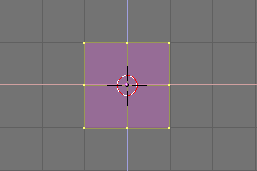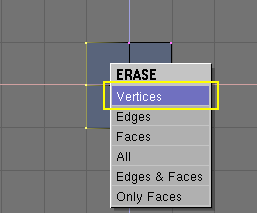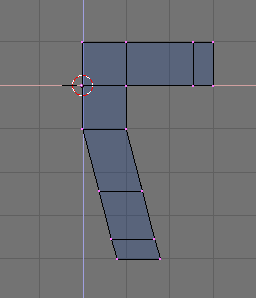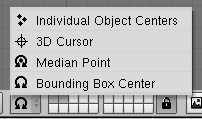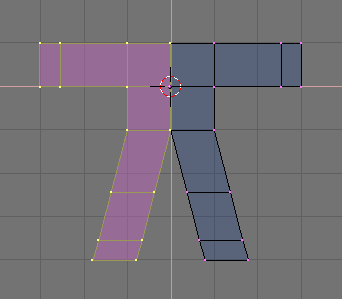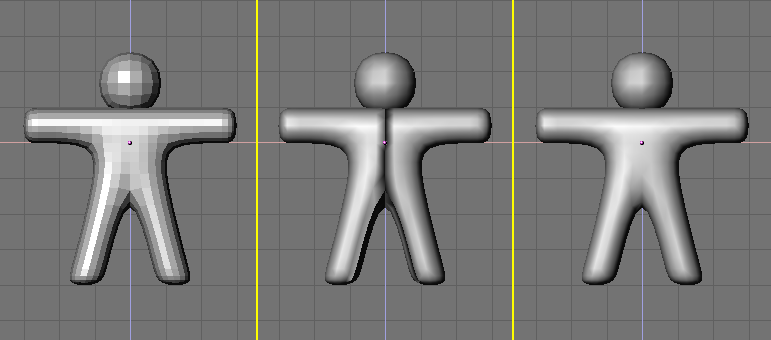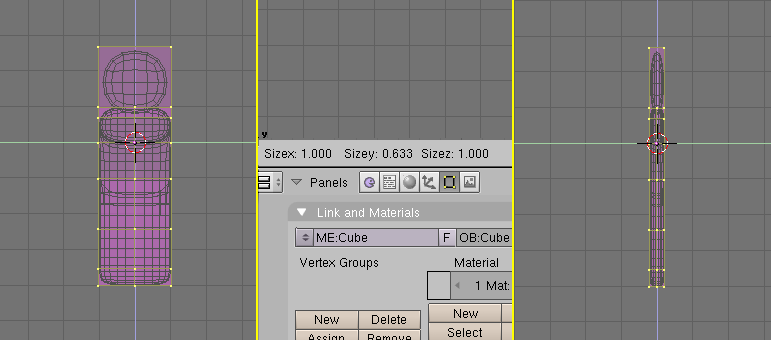Relevant to Blender v2.31
Change to the front view with NUM1
and add a cube by pressing SPACE
and selecting menu Add,
submenu Mesh, sub-submenu
Cube. (In the book we will use
SPACE>>ADD>>Mesh>>Cube
as shorthand for these kinds of actions).
A cube will appear (Figure 4.4, “Our cube in EditMode, all vertices selected.”). This newly
added cube is
in EditMode, a mode in which you can
move the single vertices that comprise the mesh.
By default, all vertices are selected (highlighted in yellow - unselected
vertices are pink).
We will call our Gingerbread man "Gus". Our first task is to build Gus's body by working on our cube in EditMode. To see the Blender tools that we'll use for this purpose, press the button showing a square with yellow vertices in the Button window header (Figure 4.5, “The Edit Buttons Window button.”), or press F9.
Now locate the Subdivide
button in the Mesh Tools panel
and press it once (Figure 4.6, “The Edit Buttons window for a Mesh.”). This
will split each side of the cube in two, creating
new vertices and faces (Figure 4.7, “The cube, subdivided once.”).
With your cursor hovering in the 3D window press AKEY to deselect all elements. Vertices will turn pink. Now press BKEY; the cursor will change to a couple of orthogonal grey lines. Move the cursor above the top left corner of the cube, press and hold LMB, then drag the mouse down and to the right so that the grey box encompasses all the leftmost vertices. Now release the LMB. This sequence, which lets you select a group of vertices in a box, is summarized in Figure 4.8, “The sequence of Box selecting a group of vertices.”.
Box Select
On many occasions you may have vertices hidden behind other vertices, as is the case here. Our subdivided cube has 26 vertices, yet you can only see nine because the others are hidden.
A normal RMB click selects only one of these stacked vertices, whereas a box select selects all. Thus, in this case, even if you see only three vertices turning yellow you have actually selected nine vertices.
Now press XKEY and, from the
menu that pops up, select Vertices
to erase the selected vertices (Figure 4.9, “The pop-up menu of the Delete (XKEY)
action.”).
Undo
Introduced in version 2.3, Blender has a Mesh Undo feature. Pressing UKEY in EditMode makes Blender Undo the last Mesh edit. Keep pressing UKEY to roll back changes as long as the Undo buffer will allow, while SHIFT-U re-does changes. ALT-U opens a menu with a list of possible undoes, so that you can easily find the point to which you want to revert to.
Mesh Undo works only in EditMode and only for one mesh at a time. Undo data is not lost when you switch out of EditMode, only when you start editing a different mesh.
Another way to revert to the previously saved state is to press ESC in the middle of an action. This cancels the action, reverting to the previous state.
Now, using the sequence you just learned, Box Select
the two top-rightmost vertices (Figure 4.10, “Extruding the arm in two steps.”,
left). Press
EKEY and click on the
Extrude menu entry to extrude them.
This will create new vertices and faces which you can move
and which will follow the mouse. Move them
to the right.
To constrain the movement horizontally or vertically, click MMB while moving. You can switch back to unconstrained movement by clicking MMB again. Alternatively you can use XKEY to constrain movement to x axis, YKEY for y axis and so on.
Let's create Gus's arms and legs. Move these new vertices one and a half squares to the right, then click LMB to fix their position.
Extrude again with EKEY then move the new vertices another half square to the right. Figure 4.10, “Extruding the arm in two steps.” show this sequence.
Gus should now have a left arm (he's facing us). We will build the left leg the same way by extruding the lower vertices. Try to produce something like that shown in Figure 4.11, “Half body.”.
Note
We use the Extrude tool three times to produce the leg. We don't care about elbows, but we will need a knee later on!
Coincident vertices
If you extrude, and in the process of moving you
change your mind and press ESC
to recover, the extruded vertices will still be
there, in their original location! While you can move, scale,
or rotate them by pressing
GKEY, you probably
don't want to extrude them again.
To fully undo the extrusion, look
for the Remove Doubles
button, highlighted in Figure 4.12, “The Edit Buttons window.”.
This will eliminate
coincident vertices.
Note
The CD contains a .blend file with this example, saved at
various modelling phases. The first file, Quickstart00.blend
contains what you should have obtained up to now.
Subsequent steps are numbered progressively,
Quickstart01.blend, Quickstart02.blend
and so on, while Quickstart.blend contains the final
result. This standard applies to all other examples in the Book.
Now we'll create the other half of Gus:
1. Select all vertices (AKEY)
and choose the 3D Cursor entry
in the Rotation/Scaling Pivot Menu of the 3D Window header.
(Figure 4.13, “Setting the reference center to the cursor.”).
2. Press SHIFT-D to duplicate all selected vertices, edges, and faces. The new objects are in Grab mode, press ESC to exit from this mode without moving the vertices.
3. Press MKEY to open the Mirror Axis Menu.
Choose Global X.
The result is shown in Figure 4.14, “Flip the copy of the half body to obtain a full body.”.
4. Deselect all then reselect all by pressing AKEY
twice, then eliminate the coincident vertices by pressing
the Remove doubles button (Figure 4.12, “The Edit Buttons window.”).
A box will appear, notifying you that eight vertices
have been removed.
Reference center
In Blender, scaling, rotating and other mesh
modifications occur either with respect to the cursor
position, the object's center, or the barycenter (center of mass)
of the selected items, depending upon which entry of the
Rotation/Scaling Pivot Menu
(Figure 4.13, “Setting the reference center to the cursor.”) is active. The crosshair
button selects the cursor
as reference.
Moving the cursor
To place the cursor at a specific grid point,
position it
next to where you want it and press
SHIFT-S to bring up the
Snap Menu. The entry Curs->Grid
places the cursor exactly on a grid point. The
Curs->Sel places it exactly on the
selected object. The other entries move objects
other than the cursor.
Gus Needs a head:
1. Move the cursor so that it is exactly one grid square above Gus' body (Figure 4.15, “The sequence of adding the head.”, left). Add a new cube here (SPACE>>ADD>>Mesh>>Cube).
2. Press GKEY to switch to Grab Mode and move the newly created vertices down, constraining the movement with MMB, for about one third of a grid unit (Figure 4.15, “The sequence of adding the head.”, right).
3. This produces a rough figure at best. To make it smoother, locate
the SubSurf Toggle Button (Figure 4.16, “The Edit Buttons window.”) in the Mesh panel and
switch it on. Be sure to set both the two NumButtons below
to 2.
Note
SubSurfacing is an advanced modelling tool, it dynamically refines a given coarse mesh creating a much denser mesh and locating the vertices of the finer mesh so that they smoothly follow the original coarse mesh. The shape of the Object is still controlled by the location of the coarse mesh vertices, but the rendered shape is the smooth, fine mesh one.
4. Switch out of EditMode (TAB) and switch from the current default Wireframe mode to Solid mode with ZKEY to have a look at Gus. He should look like Figure 4.17, “Setting Gus to smooth.” left.
5. To make Gus look smooth, press the
SetSmooth button in
Figure 4.16, “The Edit Buttons window.”. Gus
will now appear smooth but with funny black lines in his middle
(Figure 4.17, “Setting Gus to smooth.”, middle).
These lines appear because the SubSurfed finer mesh is computed
using information about the coarse mesh normal
directions, which may not be self consistent, that is, some face
normals might point outward, some inward, if extrusions
and flippings have been made.
To reset the normals, switch back to EditMode
(TAB), select all vertices
(AKEY), and press CTRL-N.
Click with LMB on the Recalc
normals outside box which appears. Now Gus should be nice
and smooth, as shown in
Figure 4.17, “Setting Gus to smooth.”,
right.
Press MMB and drag the mouse around to view Gus from all angles. Oops, he is too thick! To fix that, switch to side view NUM3. Now, switch to EditMode (if you are not there already), then back to Wireframe mode (ZKEY), and select all vertices with AKEY (Figure 4.18, “Slimming Gus using constrained scaling.”, left).
Let's make Gus thinner:
1. Press SKEY and start to move the mouse horizontally. (Click MMB to constrain scaling to just one axis or press YKEY to obtain the same result). If you now move the mouse toward Gus he should become thinner but remain the same height.
2. The three numbers on the 3DWindow toolbar show the scaling factor. Once you constrained scaling, only one of these numbers will vary. Press and hold CTRL. The scale factor will now vary in discrete steps of value 0.1. Scale Gus down so that the factor is 0.2, then set this dimension by clicking LMB.
3. Return to Front view and to Solid mode (ZKEY), then rotate your view via MMB. Gus is much better now!



